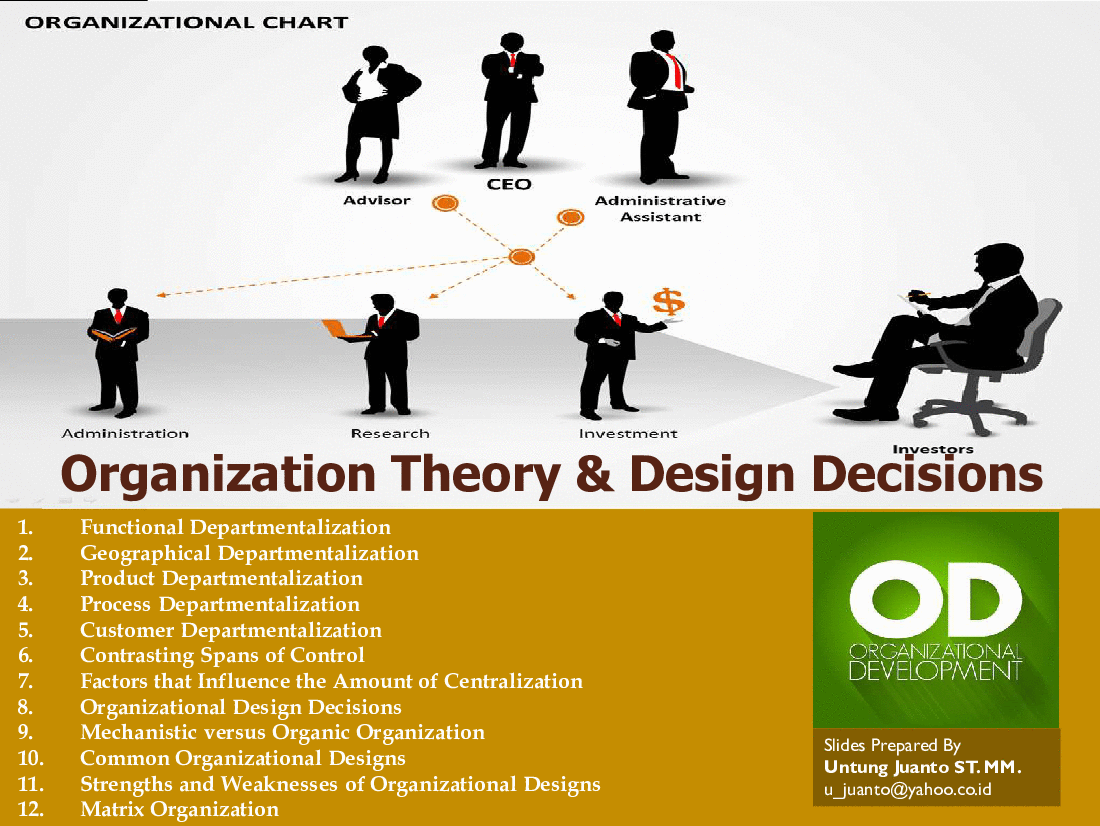Organization Theory (PowerPoint PPT Slide Deck)
PowerPoint (PPT) 46 Slides
BENEFITS OF THIS POWERPOINT DOCUMENT
- Provides of Strengths and Weaknesses of Organizational Designs
- Provides of Organizational Design Decisions
- Provides of Contrasting Spans of Control
ORGANIZATIONAL DESIGN PPT DESCRIPTION
An organization design PPT, when it is established, of course has the intention why it looks like that. The formal form of the organization is expected to be the best form that fully supports the achievement of the founder's goals or vision of the organization. This formal configuration is known as the organizational structure.
Organization Design PPT is a process for shaping the way organizations are structured and run. The theory of Organization Design involves many different aspects of life at work, including team formations, shift patterns, lines of reporting, decision-making procedures, communication channels, and more.
Organizational Design PPT – and redesign – can help any type of organization to achieve its goals. Sometimes, a large-scale reorganization is necessary. At other points, more subtle shifts in structures and systems can ensure that an organization continues to thrive.
However, unfortunately, sometimes the formation of the organizational structure and the formal relations/relationships in it have not fully 'shaded' with the vision of the organization. Sometimes there is a 'mismatch' or not 'link' with the strategic goals of the organization. Even in some cases it does not fully reflect the basic principles of a good organizational structure. For this reason, the formation of the right organizational structure is an important main requirement so that the organization's vision can be achieved.
One way to form an organizational structure is to create an organizational design PPT. Organizational design PPT itself is the formation of roles, processing activities, and forms of formal relationships in an organization. In it, there is the development of the overall structure within the organization, both units and sub-units, as well as a more detailed definition of roles and processes within these units and sub-units.
In the formation of the organizational structure itself, there are several basic principles that must be possessed by the organizational structure, including:
1. Organizational structure gives priority to key customers
2. The structure is able to reduce and eliminate organizational duplication
3. Structure simplifies layers of management within the organization.
4. The organizational structure can increase the channel of communication within the organization.
5. The organizational structure provides clear roles, responsibilities and accountability.
This 40+ slide PPT presentation on organizational design PPT and theory discusses the following Organization Design topics:
1. Evolution of Organization Theory
2. Defining Organizational Structure
3. Organizational Structure
4. Departmentalization by Type
5. Functional Departmentalization
6. Geographical Departmentalization
7. Product Departmentalization
8. Process Departmentalization
9. Customer Departmentalization
10. Contrasting Spans of Control
11. That Influence the Amount of Centralization
12. Organizational Design Decisions
13. Mechanistic versus Organic Organization
14. Common Organizational Designs
15. Strengths and Weaknesses of Traditional Organizational Designs
16. Example of a Matrix Organization
In the evolution of Organization Theory, we break down 3 periods of contrasting organization theories:
Period 1 – Pre-Scientific Management (1880)
This initial pre-science period is the model for organization utilized by the Roman Empire. It is based on the feudal system.
Period 2 – Classical Management (1880-1930)
This second period of organization theory is represented by 2 schools of thought: (1) Scientific Management Theory, pioneered by Frederick W. Tailor (1856-1915); and Classical Organizational Theory, pioneered by Henry Fayol (1841-1925).
Period 3 – Behavioral Management (1930-1950)
This third period of Behavioral Management Theory is lead by the thought leadership of Elton Mayo (1880-1949) and Douglas McGregor (1901-1964).
Current Organization Theory thinking is called Contingency Management (1950 to present), which is founded upon Management Theory, Behavioral Management, and System Approach.
Each of these schools of thought is highlighted in the first section of this Organizational Design and Organization Theory PPT.
Got a question about the product? Email us at support@flevy.com or ask the author directly by using the "Ask the Author a Question" form. If you cannot view the preview above this document description, go here to view the large preview instead.
Source: Best Practices in Organizational Design PowerPoint Slides: Organization Theory PowerPoint (PPT) Presentation Slide Deck, UJ Consulting









